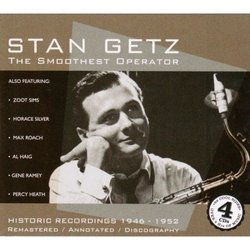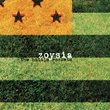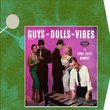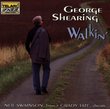| All Artists: Stan Getz Title: Getz Stan: Smoothest Operator Members Wishing: 0 Total Copies: 0 Label: Jsp Records Original Release Date: 1/1/2007 Re-Release Date: 8/28/2007 Album Type: Box set Genres: Jazz, Pop Styles: Cool Jazz, Bebop Number of Discs: 4 SwapaCD Credits: 4 UPC: 788065904326 |
Search - Stan Getz :: Getz Stan: Smoothest Operator
 | Stan Getz Getz Stan: Smoothest Operator Genres: Jazz, Pop
|
Larger Image |
CD DetailsSimilar CDs
Similarly Requested CDs
|
CD ReviewsAn Excellent Overview of Early Stan Getz Gregory M. Wasson | Pinole, CA USA | 09/03/2009 (4 out of 5 stars) "This very affordable four-disc box set is an excellent overview of the early small group recordings of Stan Getz. The disks are well re-mastered, as one would expect with the careful restoration practices used by JSP. By cut 16 of the first disc in this set, "Stan Gets Along," he shows that he is already a master of the tenor sax and is well on his way to developing the distinctive and lyrical musical voice that earned him the nickname "the Sound." This track also coincides with the first session in this set recorded on magnetic tape rather than the electronic recording technology of the age of 78's when sound engineers were still literally cutting records directly onto wax or metal master discs. The huge advance in recording technology brought by tape-recording, and the remarkably fast development of Stan Getz's own trademark style, which is instantly recognizable, intersect at "Stan Getz Along." The quality of both the sound and the music itself maintains that high standard for the rest of the box.
Stan Getz was a true prodigy, starting his career at 16 playing in a number of bands including those of Jack Teagarden and, most famously, the "Second Herd" of the Woody Herman band. It was in Herman's band that Stan Getz was brought to the attention of the jazz world with his recordings of "Early Autumn" and "Four Brothers." This box limits itself, however, to Getz's work as a leader of small groups, his preferred recording setting throughout his career. This box includes much of the famous Roost recordings, both live and in the studio, as well as a generous and well-selected sampling of Getz's work throughout the period 1946-1952. Even fans of Getz may be surprised to find how great these early small-group sides are. As early as 1947-48, we can hear Stan developing his own style and moving away from the complex and angular early bop school of Charlie Parker. His musical voice also becomes his own as he charts a course away from the obvious influence of Lester Young. Apart from his playing, which even at this stage is a wonder to hear, one can tell a lot about a player's reputation among his peers by the company he keeps, in the studio and onstage. Two players heard in particular bear mentioning by name. Al Haig was already a veteran of the first Charlie Parker-Dizzy Gillespie quintet when he joined Getz's band, and is a remarkable piano player in his own right. He has been undeservedly neglected by most jazz historians. The other is Jimmy Raney, the guitarist who played in Getz's quartets and quintets in various combinations through the early 1950s until they had a falling out over Getz's drug use. To hear Stan Getz play with these two sidemen is worth the price of the box in itself. But we also hear Duke Jordan and Horace Silver on piano, Curly Russell on bass, Roy Haynes on drums, and similar artists -- in other words, some of the best players modern Jazz had to offer at that time. The only reason I don't give this box 5 stars is because Getz was such a prolific recording artist that I can't absolutely recommend this box as the first place to start in getting to know his work. It's hard to choose between so many great albums made with so many great musicians. His recordings with Dizzy Gillespie, Sonny Stitt, Oscar Peterson, J.J. Johnson, Chick Corea, Kenny Barron, Ray Brown and many others from the mid-1950s until his death in 1991 are numerous, mostly in print, and generally of high quality. For Getz fans who already have such albums as the 1954 "For Musicians Only," 1957's "Stan Getz and the Oscar Peterson Trio," not to mention "Sweet Rain" and the popular "bossa nova" albums such as "Getz/Gilberto" from the 60's, I would strongly recommend picking up this slice of jazz history from JSP before it is cut out of the active catalog of available recordings. And for those who know Stan Getz's name but haven't heard much of his music, you definitely won't regret buying this box, especially at this price." |

 Track Listings (28) - Disc #1
Track Listings (28) - Disc #1



